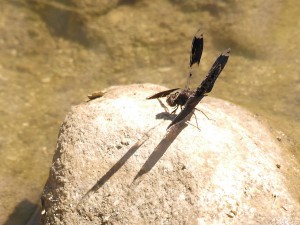When the dog days of summer become the birding doldrums, some birders turn to other flying creatures. The most accessible of these are butterflies, dragonflies, and damselflies, all of which require binoculars with excellent close focus. It was unusual recently that a birder birding San Timoteo Creek in Redlands, Riverside County, CA discovered a pair of Filigree Skimmer dragonflies (Pseudoleon superbus). As the species has only recorded twice before in California, we went to take a look.
Filigree Skimmer
Filigree Skimmer is predominantly a dragonfly of the southwest. It occurs in southeast Arizona, Colorado, New Mexico, and Texas, but also extending down through Mexico to Costa Rica. That puts this individual more than 250 miles west of the normal range. It prefers rocky streams with slow-moving water. Favorite perches include low rocks in or near water, vegetation, and rarely, flat ground away from the water. As you can see from the photos, Filigree Skimmers are mostly black with clear spaces and translucent brown areas on their wings. Male Filigrees have almost completely black hind wings. Their eyes are also quite striking, with orange and black stripes running laterally across them.
The abdomen is also black, and has gold chevrons pointing aft. One of the things that struck me as unusual was that while most dragonflies hold both sets of wings on the same plane(s) perpendicular to the thorax and abdomen as seen in the photo on the left, this Filigree Skimmer frequently held its fore- and hind wings at different angles (see image). Because of its dark color, this is thought to be a method of thermo-regulation.
Gray Sanddragon
When we arrived, the Filigree Skimmers had not yet made an appearance. Fortunately, there were plenty of other dragonflies and damselflies to keep us busy. First was a Pale-faced Clubskimmer (Brechmorhoga mendax) that never sat still and moved way too fast to get more than a blurry photo. Next, this Gray Sanddragon (Progomphus borealis) was quite cooperative, sitting on this very accessible rock for a long time.
Neon Skimmer
Finally, this Neon Skimmer (Libellula croceipennis) also made photos quite easy for us, perching on the tall grass only a few feet from the Sanddragon. Neon Skimmer is closely related to Flame Skimmer (L. saturata), which has a much wider distribution in California. Both are red in the males and orange in the females. The main distinction between the males is that Neon Skimmers have much less color on the wings. The wash extends only about 25% of the distance from the base. Flame Skimmers have the wash all the way to the nodus (the notch along the leading edge of the wings). Females of both species are quite similar. In both genders, Flame Skimmers have brown streaks in the base of the wings, while Neons don’t. You can see a video of a female Flame Skimmer in our Wildlife Photography is Like a Box of Chocolates blog post.




 see image
see image
